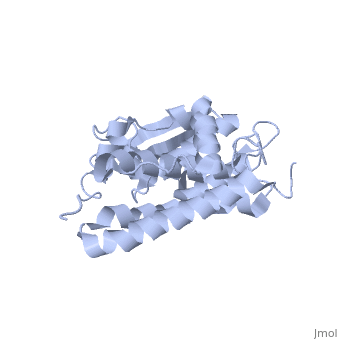User:Amy Kerzmann/Sandbox 4
From Proteopedia
| (5 intermediate revisions not shown.) | |||
| Line 1: | Line 1: | ||
| - | == | + | == Chloride Ion Channel == |
| - | <applet load=' | + | |
| - | + | Crystal structure of a soluble form of CLIC1. An intracellular chloride ion channel | |
| - | + | ||
| - | + | <applet load='1k0o' size='300' frame='true' align='right' caption='Insert caption here' /> | |
| - | + | ||
| - | + | CLIC1 (NCC27) is a member of the highly conserved class of chloride ion channels that exists in both soluble and integral membrane forms. Purified CLIC1 can integrate into synthetic lipid bilayers forming a chloride channel with similar properties to those observed in vivo. The structure of the soluble form of CLIC1 has been determined at 1.4-A resolution. The protein is monomeric and structurally homologous to the glutathione S-transferase superfamily, and it has a redox-active site resembling glutaredoxin. The structure of the complex of CLIC1 with glutathione shows that glutathione occupies the redox-active site, which is adjacent to an open, elongated slot lined by basic residues. Integration of CLIC1 into the membrane is likely to require a major structural rearrangement, probably of the N-domain (residues 1-90), with the putative transmembrane helix arising from residues in the vicinity of the redox-active site. The structure indicates that CLIC1 is likely to be controlled by redox-dependent processes. | |
| - | The | + | Crystal structure of a soluble form of the intracellular chloride ion channel CLIC1 (NCC27) at 1.4-A resolution. |
| - | + | ||
| - | == | + | |
| - | + | == About this Structure == | |
| + | |||
| + | |||
| + | |||
| + | 1K0O is a 2 chains structure of sequences from Homo sapiens. Full crystallographic information is available from OCA. | ||
| + | [edit] | ||
| + | |||
| - | == pH Gating == | ||
| - | |||
| - | |||
| - | |||
== References == | == References == | ||
| - | <references /> | + | |
| + | <references/> | ||
| + | |||
| + | <ref>PMID:#11551966</ref> | ||
| + | |||
| + | Harrop SJ, DeMaere MZ, Fairlie WD, Reztsova T, Valenzuela SM, Mazzanti M, Tonini R, Qiu MR, Jankova L, Warton K, Bauskin AR, Wu WM, Pankhurst S, Campbell TJ, Breit SN, Curmi PM. Crystal structure of a soluble form of the intracellular chloride ion channel CLIC1 (NCC27) at 1.4-A resolution. J Biol Chem. 2001 Nov 30;276(48):44993-5000. Epub 2001 Sep 10. PMID:11551966 | ||
Current revision
Chloride Ion Channel
Crystal structure of a soluble form of CLIC1. An intracellular chloride ion channel
|
CLIC1 (NCC27) is a member of the highly conserved class of chloride ion channels that exists in both soluble and integral membrane forms. Purified CLIC1 can integrate into synthetic lipid bilayers forming a chloride channel with similar properties to those observed in vivo. The structure of the soluble form of CLIC1 has been determined at 1.4-A resolution. The protein is monomeric and structurally homologous to the glutathione S-transferase superfamily, and it has a redox-active site resembling glutaredoxin. The structure of the complex of CLIC1 with glutathione shows that glutathione occupies the redox-active site, which is adjacent to an open, elongated slot lined by basic residues. Integration of CLIC1 into the membrane is likely to require a major structural rearrangement, probably of the N-domain (residues 1-90), with the putative transmembrane helix arising from residues in the vicinity of the redox-active site. The structure indicates that CLIC1 is likely to be controlled by redox-dependent processes. Crystal structure of a soluble form of the intracellular chloride ion channel CLIC1 (NCC27) at 1.4-A resolution.
About this Structure
1K0O is a 2 chains structure of sequences from Homo sapiens. Full crystallographic information is available from OCA. [edit]
References
Harrop SJ, DeMaere MZ, Fairlie WD, Reztsova T, Valenzuela SM, Mazzanti M, Tonini R, Qiu MR, Jankova L, Warton K, Bauskin AR, Wu WM, Pankhurst S, Campbell TJ, Breit SN, Curmi PM. Crystal structure of a soluble form of the intracellular chloride ion channel CLIC1 (NCC27) at 1.4-A resolution. J Biol Chem. 2001 Nov 30;276(48):44993-5000. Epub 2001 Sep 10. PMID:11551966

